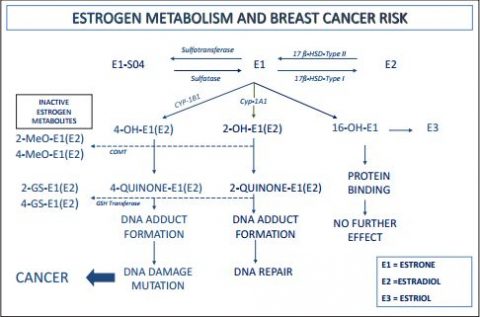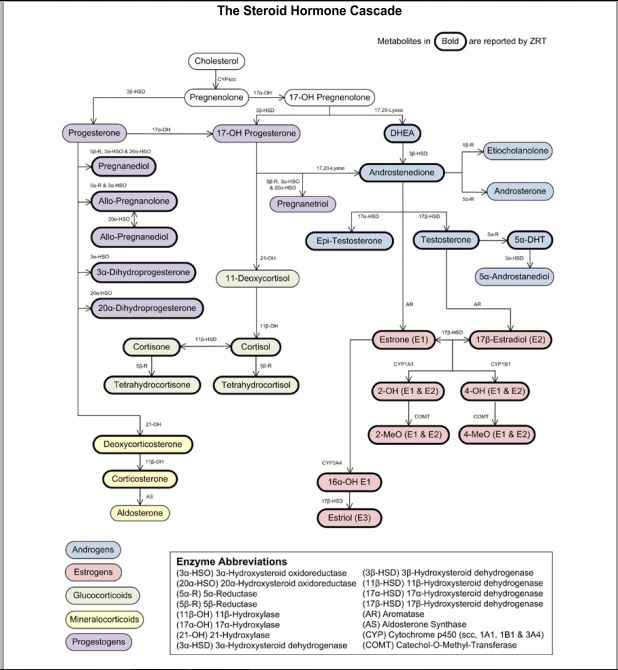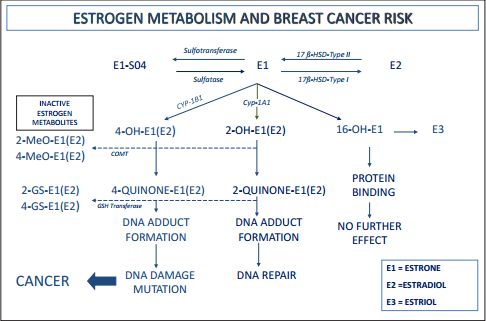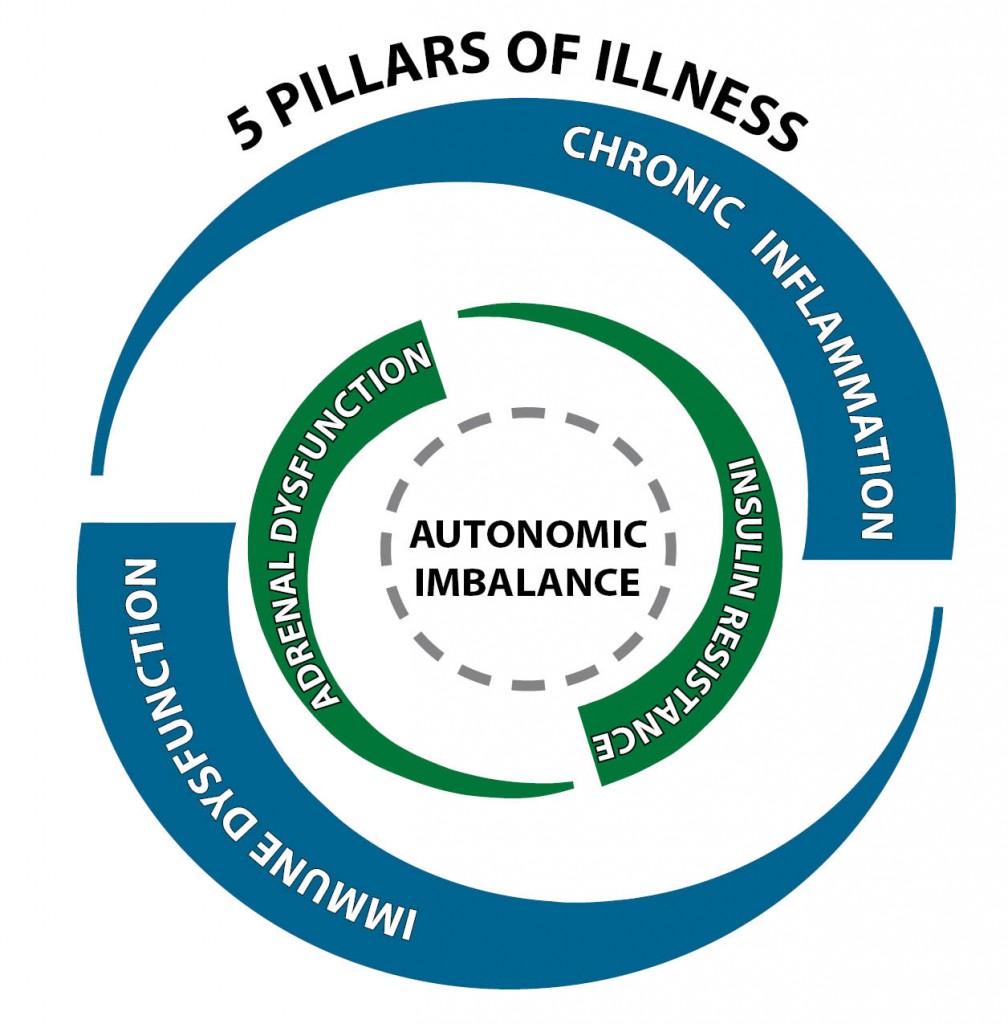
For the majority of women, they are on birth control pills to prevent birth. Despite it being my wife’s body, one thing I was adamant when we got married was that she never be on birth control pills. It has nothing to do with a religious belief but the reality that I wanted my wife around for the long haul in life. I didn’t want her bombarded with extra estrogen for health reasons.
Don’t get me wrong, estrogen is essential to health but too much is detrimental to life. Just think about it, adding more estrogen into the body is a treatment to prevent the formation of life. If it has enough effect on the body to prevent a new life from forming, what effect does it have on a life that is daily attempting to build, repair, and heal?
Estrogen (as with testosterone) is a steroid hormone, synthesized from cholesterol. Since cholesterol is the basis for all these steroid hormones, in a statin-crazed-cholesterol-is-evil society, are we creating our exponential increase in hormone imbalances in the name of heart health?
Cholesterol is also the basis of Cortisol, which is your prime life saving, stress-induced, survival hormone. The body will favor survival over sex any day. It’s not news that we are a stressed out society, physically, chemically, and emotionally. Again, is the pursuit of bigger and better also a hit to our hormone imbalances?
Once estrogen is made, it’s released into the bloodstream, where it targets specific tissues and binds to a hormone receptor. The marriage of the hormone and receptor then activates a host of genetic reactions to stimulate cell growth, healing and repair. When you hear steroid hormones, think steroids. These are hormones to build the body up.
Over use, the hormone receptors will start to degrade and release estrogen. Estrogen may bind to another receptor to continue the process of growth, healing, and repair or it may re-enter circulation and have to pass through the liver to begin the process of elimination.
This breakdown of estrogen (and other hormones and toxins) occur in 2 phases in the liver. The primary purpose of phase 1 is to make the hormone or toxin more water soluble through a group of enzymes called Cytochrome P450. Phase 2 is to conjugate (unite as in conjugal visit) a methyl group, sulfate or glucuronide group. These conjugate groups make the molecule inactive (inert), totally water soluble, and ready to be flushed through your urine by the kidneys and into the toilette bowl. This why I advise against drinking tap water.
This will get a little technical. 2 forms of estrogens (estrone and estradiol) are converted to 2-HydroxyEstrogens and 4-HydroxyEstrogen. This is done in that first phase of liver detox using the Cytochrome P450 enzymes I mentioned previously. These 2 and 4 HydroxyEstrogens are then either methylated (phase 2 detox) or oxidized (rusted).
The oxidized versions are called quinones. Quinones are nucleophilic (they love DNA material). Therefore they have a propensity to attach to DNA, which causes damage to your health expression. To sustain life, your DNA makes photocopies of itself. Then a photocopy of a photocopy. Then a photocopy of a photocopy of a photocopy and so on. What happens over time when you are making photocopies of photocopies? They fade. If you aren’t properly maintaining your ink levels, paper quality, etc, mistakes happen. Same with the body.
If you don’t maintain all the necessary aspects to replicate DNA, photocopies can be altered. These alterations can be triggered by quinones.
Why would these quinones form? It could be a lack of methylation factors (many people have what is known as Single Nucleotide Polymorphisms (SNPs) that inhibit liver detox pathways and DNA protection). It could be a lack of antioxidants (DNA protection) from poor diet, lack of movement, and other deficiencies. It could be a toxic burden (DNA attackers) that the liver cannot sustain what is needed to detox everything effectively, including hormones.
It’s the 4 HydroxyEstrogen quinones that are the most potentially damaging. It’s this oxidation and resultant inflammation that have much underlying contributions to diseases like breast cancer. This could be why any study that comes out from someone on birth control or hormone replacement therapy long term has exponential increases in breast cancer rates.
What does this have to do with birth control pills? Birth control pills introduce an abundance of estrogens. If this were the only toxic burden the body had to face, it may not be such a big deal. But it isn’t. We live in a toxic world of many things we don’t see, smell, taste, or hear. Plastics, pesticides, COSMETICS, perfumes, lotions, anything Bath and Body Works, and tap water are toxic. These toxins act like estrogens in the body, increasing the estrogen load and demand of proper liver detox pathways.
Our visceral fat stores (butt, gut, and thighs) also release an enzyme called aromatase that converts testosterone to estrogen. How many Americans do you know that don’t have some sort of a spare tire? When you see the spare tire, don’t think fat, think excess estrogen, inflammation, and insulin.
Many of these things also lead to increase in inflammation load. As inflammation increases, so does the demand for anti-oxidants and if someone doesn’t have sufficient amounts, this goes back to favoring quinone production.
One last factor to consider is Sex Hormone Binding Globulin (SHBG). SHBG is a protein made in the liver with the purpose of attaching to sex hormones like estrogen to limit activity and act as a storage until needed. The problem occurs when someone is insulin resistant. Insulin (anabolic steroid hormone) floating around stimulates testosterone production. It also stimulates cholesterol production. An increase in testosterone will decrease SHBG production. If there is an abundance of estrogen active in the body (not bound to SHBG), this can make cells grow and divide at a much faster pace than desired, hello breast cancer.
Estrogen will target site specific areas like breast tissue. Let’s say there is ample SHBG in the system. The problem is that other hormones have a higher affinity to SHBG than estrogen; hormones like thyroid, pituitary, and testosterone will be gobbled up before estrogen. Not only can you be leaving excess estrogen in the system, other hormones become inactive. Look at the rampant abundance of Low T and thyroid issues.
Take this scenario. Let’s say you get your TSH checked and it’s high. Your doctor may automatically think you’re hypothyroid and place you on Synthroid. He/she never asked WHY TSH is high. Is TSH high because your thyroid isn’t functioning or is SHBG robbing TSH to make it inactive and the pituitary is then signaling for more TSH release? There’s so many scenarios.
This is why I say rethink birth control pills because this is one toxin you can control putting in your body. It’s not the only thing that will contribute to potential oxidative burden but it’s one thing you can absolutely limit. The lazy healthcare model is just to throw a bunch of progesterone at the situation to balance the estrogen levels. Ridiculous.
If estrogen is not being detoxed properly and re-circulated through the body, how many women do you know that can’t get pregnant after having been on birth control for years? They probably at least have a liver detox problem, methylation problems not allowing their body clear excess estrogen, thus not being able to conceive.
Ultimately any hormone imbalance comes down to 5 factors that need to be addressed: Autonomic Imbalance, Adrenal Dysfunction, Insulin Resistance, Immune Dysfunction, and Chronic Inflammation.
Stop settling for the standard, reductionistic, compartmentalized model of ‘healthcare.’ You have choices. Don’t settle. You know how to find us.





I’m curious about your take on progesterone only contraceptives, as this is the form I actually find myself prescribing the most. Combined oral contraceptives have fallen put of favor, in large part, due to the increased DVT and reproductive cancers. That, along with the fact that most women are not consistent with their pills. Do you feel this move to progesterone only is beneficial?
My quick take on hormones is that one should be very cautious with adding hormones into the body. Because hormones work on a negative feedback loop system in the body, I would be afraid that the body would have the same reaction of seeing the hormone, not need to produce it, so the mechanism for producing that hormone gets deconditioned, setting up another hormone imbalance, especially when the woman is done taking that hormone. The short term gain has to be weighed versus the long term consequence.